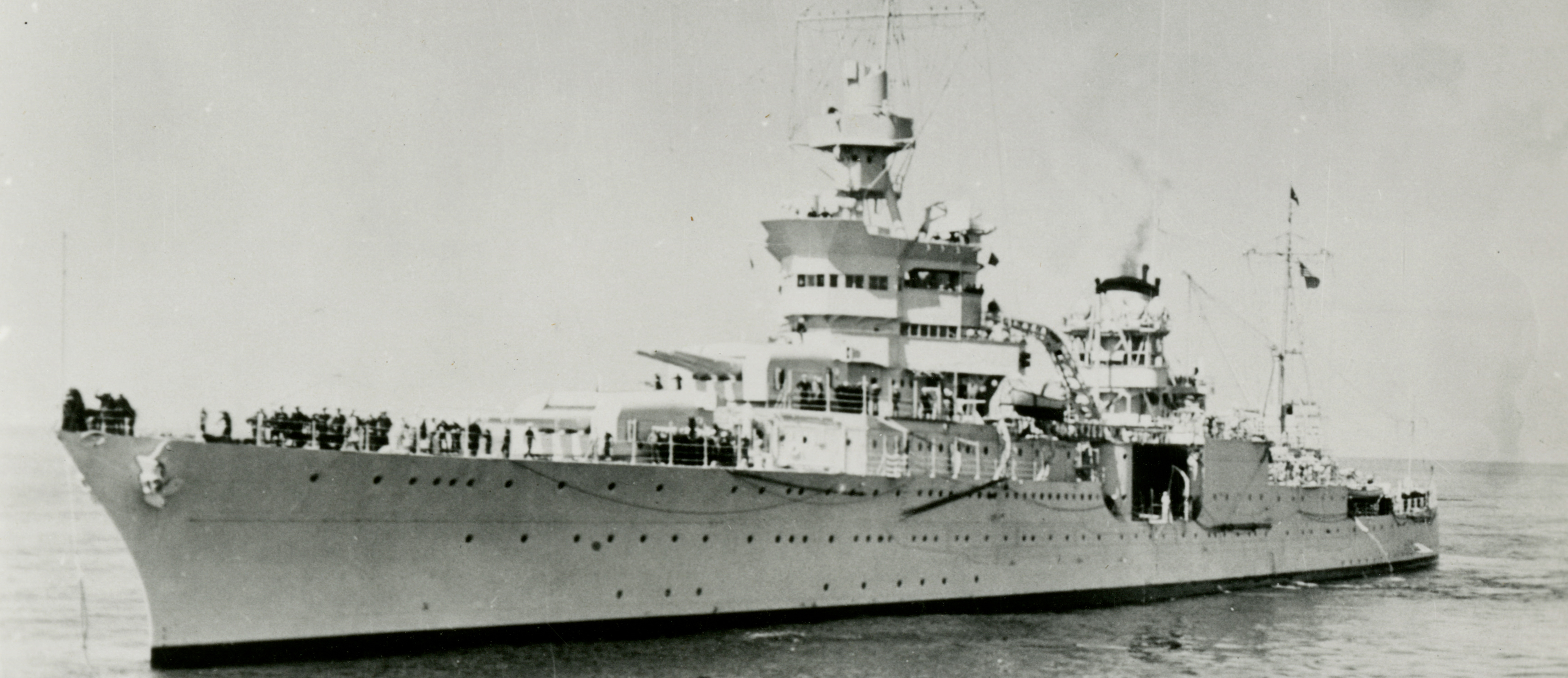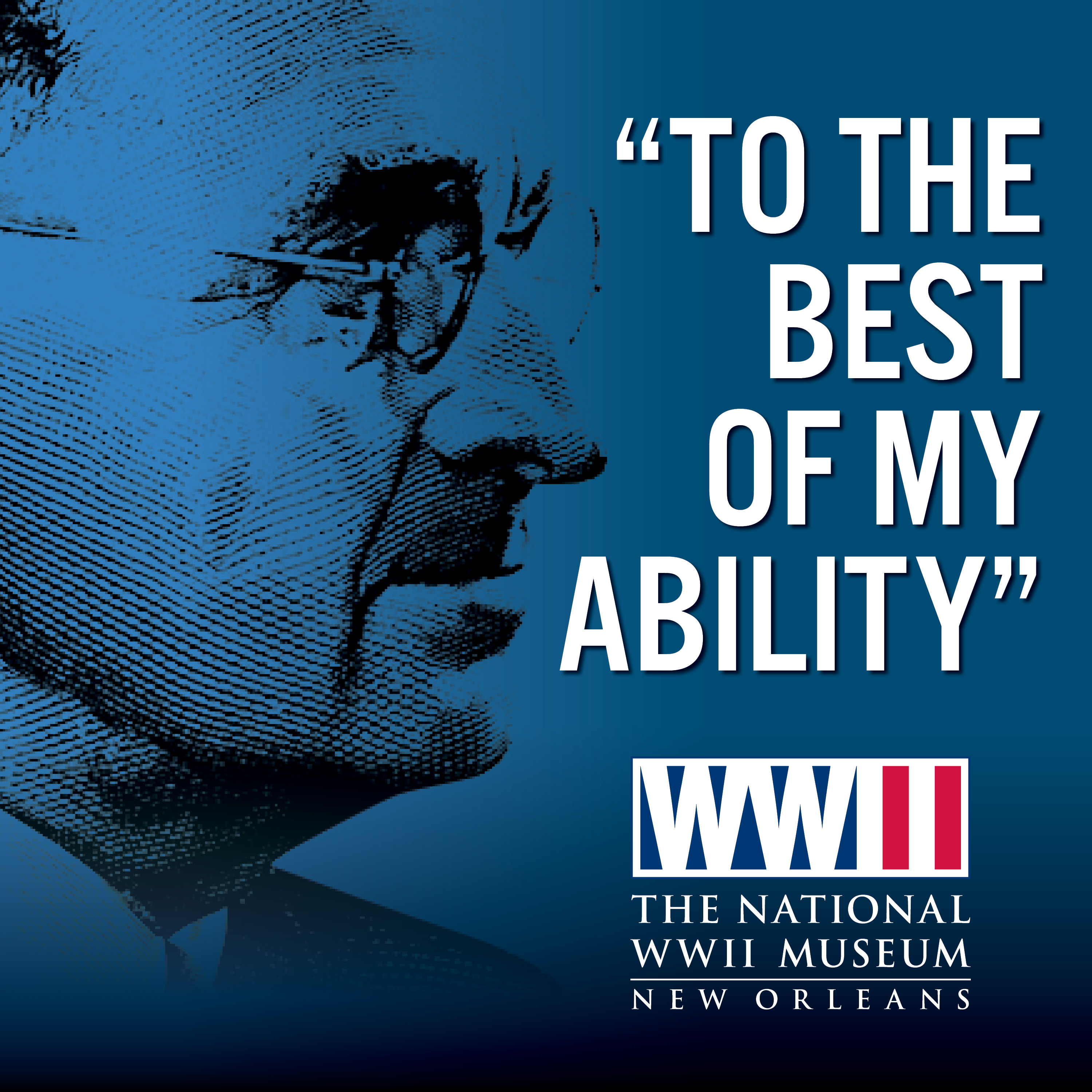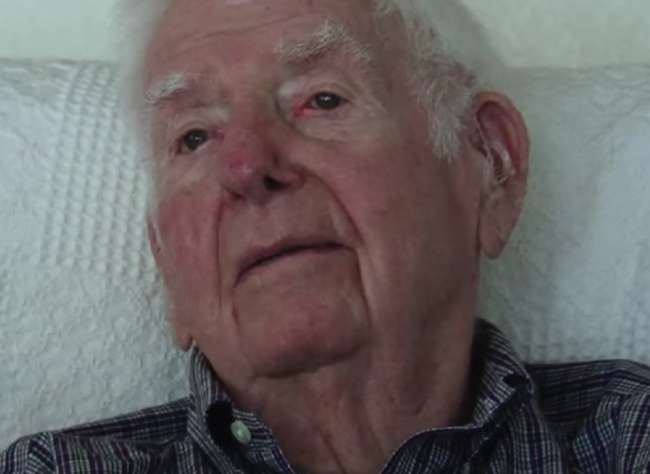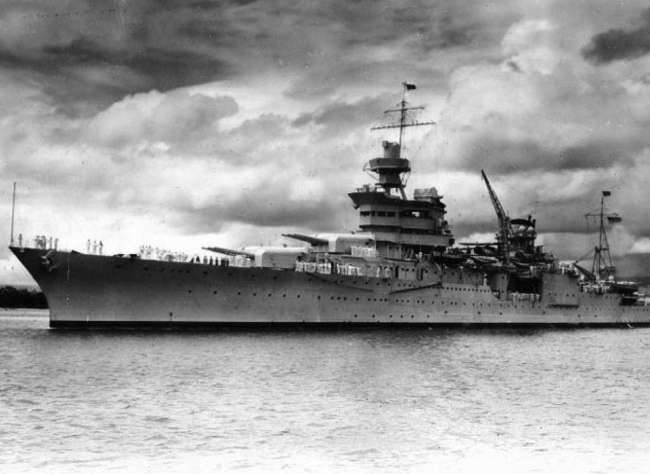Listen: Apple Podcasts, Spotify.
About the Episode
In July 1945, after the success of the Trinity Test, President Truman ordered that the new atomic bombs be ready for assembly and potential use as quickly as possible. Truman, who was at the Potsdam Conference at the time, wanted the bombs prepared should the leaders of Japan refuse the final opportunity offered to surrender. In the midst of the conference, a number of ships sent parts for the new atomic bombs to the island of Tinian. Among the ships sent to Tinian was the USS Indianapolis, which carried key parts for the bomb codenamed “Little Boy,” including the enriched uranium core and gun-trigger method needed to detonate the bomb. After completing this mission, the USS Indianapolis moved away from the front line of fighting and halted defensive maneuvers, as the captain and crew had not received any reports of enemy submarines in the area. This decision proved catastrophic on July 30, 1945, when a Japanese submarine launched a torpedo strike against the Indianapolis, sinking the heavy cruiser in twelve minutes. The sinking left nearly 900 men in the water for days, as the US Navy did not know the location of the Indianapolis when it sank, or that the ship had been sunk at all.
This week’s episode, written and narrated by the Museum’s Dr. Kristen Burton, opens with an audio clip from Truman’s address to the Empire of Japan, in which he issued a public warning to Japan’s leaders to surrender or else suffer complete ruin. These remarks foreshadowed the use of atomic bombs against Japan in August 1945, and also the issuance of orders that put into motion a series of events, including the top-secret mission that sent the USS Indianapolis to Tinian. This episode features oral histories, conducted by the Museum’s curator of oral history Joey Balfour, from veterans Harlan Twible and Richard Thelen who were aboard the Indianapolis the night of the sinking.
The story of the USS Indianapolis became buried in the press, as the end of the war against Japan took precedence over news of the sinking. However, release of the Steven Spielberg film Jaws in 1975 brought renewed attention to the story of the Indianapolis, as the fictional character Captain Quint relayed an account of the sinking. Captain Quint’s monologue tells the harrowing account of how the men who survived the sinking had to endure four days in the water fighting off shark attacks. Although a fictional character, the details in Captain Quint’s monologue remains largely faithful to the actual events that occurred.
As the US Navy did not know the location of the USS Indianapolis at the time of the attack, the site of the wreckage remained unknown until August 19, 2017. An expedition funded and led by Microsoft co-founder, Paul G. Allen, eventually found the Indianapolis at a depth of 18,000 feet on the seafloor of the Phillippine Sea.
Topics Covered in this Episode
- Truman’s decision to drop the atomic bomb on Japan
- Delivery of parts for the atomic bombs to the Pacific
- The sinking of the USS Indianapolis
- Oral history accounts from Harlan Twible and Richard Thelen
- Details of the shark attacks that following the sinking of the Indianapolis
- The suicide of Captain Charles McVay
Featured Historian
Seth Paridon
Seth Paridon served as a staff historian at The National WWII Museum since 2005, and digital content manager in the WWII Media and Education Center from 2017 until 2020. He began his career conducting oral histories and research for HBO’s miniseries The Pacific and holds the distinction of being the first historian hired by the Museum’s Research Department. In the 12 years he was Manager of Research Services, Paridon and his team increased the oral history collection from 25 to nearly 5,000 oral histories. He also served as the host of Service on Celluloid, the Museum's podcast dedicated to screen depictions of World War II, from 2018–2020. He is currently deputy director of the Mississippi Armed Forces Museum at Camp Shelby.
Related Content
-
Article Type
Harlan Twible, USS Indianapolis (CA-35)
After delivering vital parts to the island of Tinian for the atomic bomb that would be dropped on Hiroshima, the heavy cruiser USS Indianapolis was struck by two enemy torpedoes on July 29, 1945. The ship sank in twelve minutes.
-
Article Type
Surviving the Sinking of the USS Indianapolis
Hundreds of the ship's crew floated on the Pacific for days. Their location and fate were unknown to the US Navy.
-
Contributor
Kristen D. Burton, PhD
Kristen D. Burton, PhD, is a former Teacher Programs and Curriculum Specialist at The National WWII Museum.
Sponsors
"To the Best of My Ability" is part of an ongoing series commemorating the 75th Anniversary of the End of World War II made possible by The Nierenberg Family and Bank of America.
Transcript
Archival Audio, “Truman Warns Japs to Give Up”
What has already happened to Tokyo will happen to every Japanese city whose industries feed the Japanese war machine. If the Japanese insist on continuing resistance beyond the point of reason, their country will suffer the same destruction as Germany. Our blows will destroy their whole modern industrial plant and organization, which they have built up during the past century, and which they are now devoting to a hopeless cause.
We have no desire or intention to destroy or enslave the Japanese people, but only surrender can prevent the kind of ruin which they have seen come to Germany as a result of continued, useless resistance.
Dr. Kristen Burton
In late July 1945, Japan’s refusal to accept the Potsdam Declaration solidified Truman’s decision to use the atomic bomb, accelerating a series of events that would lead to more casualties before war’s end. Parts of the new atomic bombs were sent in separate ships to the Mariana Islands for assembly, and the US officially began preparations to use these powerful new weapons in fateful strikes that Truman hoped would finally break Japan’s resolve.
Archival Audio
“I Harry S. Truman do solemnly swear to faithfully execute the Office of President of the United States, and will to the best of my ability, preserve, protect and defend the Constitution of the United States, so help me God.”
Dr. Kristen Burton
You’re listening to “To the Best of My Ability” from The National WWII Museum in New Orleans, this is episode 6, “883 Killed.” I’m your host, Dr. Kristen Burton.
This week, a top-secret mission sends the heavy cruiser USS Indianapolis to the island of Tinian to deliver enriched uranium and parts needed to assemble a new kind of bomb, codenamed “Little Boy.”
When the Indianapolis received the orders for this secret mission, the ship was in dock receiving repairs from earlier attacks in the Pacific. Sailors aboard had no idea about the nature of the mission they were about to embark upon, or the tragedy that would follow.
Joining us this week is Seth Paridon, host of the Museum’s podcast Service on Celluloid and Digital Content Manager at The National WWII Museum.
Seth Paridon
The USS Indianapolis was in San Francisco at Mare Island Naval Shipyard, being repaired from kamikaze damage that she had sustained off Okinawa a few months prior. Indy was there, as I said, undergoing repairs. She was not even actually fully repaired. I mean, the vast majority of what had been done—needed to be done was done by July, but she wasn’t really ready to go.
And a little footnote in history is that actually, Indianapolis was not the first ship chosen to transport the pieces for the atomic bomb. And that’s what Indy’s mission was that Indy was assigned to carry the uranium-235 core and the gun trigger mechanism that would be used to detonate the bomb over Hiroshima on August 6, 1945.
But she wasn’t the first one chosen. It was actually USS Pensacola. USS Pensacola was chosen to carry the bomb. And she was also under repair. She went out to test her systems, and her engines failed. So via, you know, fate, luck—or unlucky, whatever you want to call it—Pensacola was not the one chosen, and the deed was given to the USS Indianapolis.
Dr. Kristen Burton
The USS Indianapolis had a reputation for her speed, which is why she received the orders to send the bomb parts, including the uranium core, to Tinian. Truman wanted the parts for the bomb ready for assembly as soon as possible, and the Indianapolis played a key role in achieving that goal. Departing on July 16, 1945, the Indianapolis covered 5,300 nautical miles in 10 days - stopping only at Pearl Harbor along the way. The pace set by the Indianapolis set a world record for speed that still stands to this day. Upon her arrival at Tinian, the men of the Indianapolis successfully delivered the critical parts for the bomb “Little Boy.”
Seth Paridon
At the time, in July of 1945, Truman was actually in Potsdam when Indy left San Francisco and made it to Tinian. He was about to give Japan a final chance to surrender through the Potsdam Declaration: quote, “surrender or be annihilated,” unquote. And Indianapolis, in a roundabout way, was going to be a part of that Potsdam Declaration, because of course, she delivered the parts that annihilated a city.
Dr. Kristen Burton
Ensign Harlan Twible recalled being on board when the uranium and parts for “Little Boy” came off the ship. The mission was his first naval assignment.
Oral History, Harlan Twible
There was no big action on board the ship, but on the dock, there were admirals and everything. I really think everything that was of importance on the island of Tinian was there to greet the—well, it later became—we later found out was the bomb.
Dr. Kristen Burton
The successful delivery of the parts for the atomic bomb complete, the USS Indianapolis set sail for Guam in order to engage in gunnery practice. With a fresh crew that had many young, inexperienced sailors like Harlan aboard, the crew engaged in practice in preparation for the expected invasion of the Japanese home island.
Sailing around the Mariana Islands, the crew of the USS Indianapolis believed they were off the front lines of the fighting. Receiving no notice of any threats in the area, commanding officer Captain Charles McVay halted precautionary anti-submarine “zigzagging” maneuvers.
Seth Paridon
Indianapolis is cruising at a relatively slow speed for her: 17 knots. July 30th, 1945. It’s a moonless night. It’s—the visibility is very poor. You know, the seas are, you know, 8- to 10-foot swells. It’s not horrible, but it’s not the best, you know, seas. I mean, in the middle of Pacific, it’s not too bad. And Indy’s steaming, you know, as if she was at peace.
She had been zigzagging, and subm—and surface ships zigzag to throw off the aim of enemy submarines. She had been doing that earlier in the night, but she was never told—Captain McVay was never told that there was a threat of Japanese submarines in the area. Even though the US Navy knew that there was a threat of Japanese submarines in the area, they never told them. So he stopped zigzagging because he was like, well, we don’t need to.
And she was sailing a straight—straight-as-an-arrow course when Japanese submarine I-58 popped her periscope, saw Indy in her scope, and fired a spread of six torpedoes. Two of them hit the ship. The first one hit in the bow, blew the bow off the ship as she was making 17 knots. The second one hit almost midships, right near a powder magazine. So it just—you know, the detonation of Japanese torpedoes was tremendous anyway, but you put it near a fuel bunker and a—and a powder magazine and ammunition magazines, I mean, just—you can imagine what the devastation was.
It blew a huge hole in the side of the vessel. Any man with any kind of sense knew there’s no saving this thing. She doesn’t have a bow. And she’s going down. And she’s still moving, 17 knots—ish, obviously slowing down. And there’s thousands and thousands of tons of sea water that are coming through this gaping hole in her bow and now this gaping hole in her side. And she starts to settle down and roll.
Dr. Kristen Burton
Fifteen minutes past midnight on July 30, the critical torpedo strike immediately crippled the massive cruiser. Richard Thelen, who had been asleep with the torpedoes struck, recalls the night the Indianapolis sank.
Oral History, Richard Thelen
But when the torpedo hit, I went up in the air. I don’t know if I went up two feet or 20 feet, I don’t know all that. I woke myself up flying through the air. And I picked myself up, the cable goes on the other side of the ship. I had to hold a lamp while I picked myself up. So I went over and moved over about 12, 15 feet. (laughs) So I may have gone up this high and I may have gone up—I don’t know. I have no idea. But I was fortunate I was sleeping where I was because if I was sleeping over a little further over, I'd have been blown off the ship and had no life jacket on, so I would have been the first one off probably. (laughs) I don’t know. But then at that time, I couldn’t find my clothes. The only thing I had—my shorts on.
Well, okay, after the torpedoes hit, it blew off the bow then, of course, that woke me up. A few seconds later, one hit mid-ship, which really blew a big—that's when the ship really rumbled. And myself and, oh, eight, ten, six, twelve, I can't tell you exactly how many, went aft from general quarters and that complete quarterdeck was engulfed in flames. We couldn’t cross the quarterdeck. So me and the rest of us, we went forward again. By that time, the ship, it listed onto the starboard side. So somebody, I don’t know who it was, said, "Hell, we're going to sink."
Dr. Kristen Burton
With the chaos caused by the sudden attack, an order to abandon ship came from an unexpected source.
Seth Paridon
So these guys are scrambling around like crazy, trying to get off the ship. They do, obviously. And one of the things too—you know, there was never really an official abandon ship order given, except for one man, Ensign Harlan Twible.
Harlan was a young ensign, fresh from the Naval Academy, and he actually gave the order. He was up near the bow of the ship. He gave the order to abandon ship because guys are just kind of standing there. I mean, they’re—you know, some are jumping off anyway. He gives the order to abandon ship. And then they start pouring off the ship. Guys are going everywhere. There’s over 800 men in the water. A lot of them are horribly wounded from the fires and the explosions and the shrapnel and everything else. And you know, when a ship sinks, it’s chaotic anyway, and this is even more so because she was alone.
Dr. Kristen Burton
Lasting only 12 minutes, the sinking of the USS Indianapolis took roughly 300 of 1,195 crewmen down with her, leaving nearly 900 men adrift in the seas. With many of the men badly burned and injured from the explosion, and the ship heading for the ocean floor, the men floated in the water hopeful for a speedy recovery. However, due to the nature of their mission, and the belief that the Indianapolis was sailing away from immediate threats, the US Navy did not know the location of the ship when it was struck, or that the ship had sunk at all.
Left floating in the water overnight, the next morning brought a different threat to the fore. Drawn by the commotion of the sinking, and the blood in the water, a number of sharks, believed to be oceanic whitetip sharks - one of the most aggressive species - began to attack the surviving crew members, hitting Harlan, Richard, and the other men close to the surface of the water.
Oral History, Harlan Twible
They grabbed some of our people who had broken free from the net. I also noticed that everybody tied to the net the sharks didn’t attack. So every time the sharks were coming in, we would kick and scream and do the things that we thought would drive the sharks away. And they did drive them away. The sharks only picked—as far as I could say, the sharks only picked off to eat or to kill or whatever people who were by themselves—in other words, no protection around them.
Dr. Kristen Burton
Richard Thelen also described that time in the water.
Oral History, Richard Thelen
Of course, you couldn’t see them but you could feel them—feel them go by your leg. Some guys had seen a lot of sharks. I'd just seen a few. I didn’t—how many were taken. Okay, as you got outside of our group and they're, say, 50 yards or 30, 40 yards away, you could hear a guy scream or a couple of times, pools of blood will come up. They would be taken. How many I'd seen, I really can't tell you for sure.
Dr. Kristen Burton
For four days, the survivors of the sinking of the USS Indianapolis fought off shark attacks, dehydration from the daytime heat, and hypothermia from the evening chill. Many resorted to drinking the seawater due to extreme thirst, causing hallucinations, and exacerbating the horrors of the attack.
Hope of rescue waned with each passing day. The men of the Indianapolis did everything they could to help save as many as possible. Some, Harlan reflected, were so badly injured that all they could do was attempt to provide some comfort, in a place where no comfort was to be found.
Seth Paridon
And it was—it was just—it was absolutely terrifying. And it was—it was a horrible situation for those men to be in. And it was only by chance that they were ever found in the first place. The Navy did not know that they had gone down. The Navy had no clue. They didn’t send anybody out to search for them. Nobody. It was only by chance, about 10:25 AM on Thursday morning, the fourth day, an ensign by the name of Lt. Chuck Gwinn was flying a Lockheed Navy Ventura bomber.
He was out on anti-submarine patrol, ironically enough. When—he was about 300 miles away when he took off, from where the Indianapolis went down, and he happened to fly over the area. And he sees something in the water, sees a huge oil slick, and he immediately thinks, well, a submarine went down there. So he goes down to investigate the oil slick. And he sees all these people bobbing in the water, waving at him fanatically.
And he doesn’t know who they are. He has no idea. But he sends a radio message back. Boom. “Hey, we got people in the water here. Here’s the coordinates,” dadumdumdumdum. Couple hours later, a PBY, which is a Navy flying boat, comes out. They—PBYs are not supposed to land in the open ocean because they’ll swamp. (laughs) They’re not made to do that. But the pilot of this airplane realize that those are human beings in the water and I’m going to do whatever I can to save as many of them as I can.
So he puts this thing down in the middle of the water and he starts pulling people out. Only then does he—does he realize who these people are, and only then does the United States Navy know. We have survivors, American. They don’t even know what ship, just American survivors are in the water. So the PBY radios for destroyers to come help, or anybody to come help. Bunch of destroyers come out there, other vessels come out there, and they start picking people up.
Only then do they understand that these people are from the USS Indianapolis.
Dr. Kristen Burton
US warships converged on the location of the sinking and rescued the surviving crew members. Of the 1,196 men who had been aboard the Indianapolis, only 316 survived.
News of the sinking went unheard, however, due to the top-secret nature of the Indianapolis’ mission. It also quickly became overshadowed by other events in the days and weeks that followed. Efforts to keep the American public focused on the end of the war against Japan meant the story of the Indianapolis received little attention in the press.
Seth Paridon
Well, the American people found out about the sinking of the Indianapolis on the same day that the surrender of the Japanese was made public. If you look at front page headlines from August 14, 1945, you see big, blaring headlines that says, you know, Japanese surrender, whatever different variations of that, and in the New York Times in particular, the bottom right-hand corner, in a little, bitty box in the bottom right-hand corner, it says, US Navy cruiser sunk, high casualties, over 1100 casualties, or something like that that it says in the bottom of the headline. So if you’re not looking for it, you’re going to miss it. And it was done like that on purpose.
The United States government put the kibosh on the news because they didn’t want it to overshadow the surrender of Japan. They also, I mean, had to admit at some point that these people had been killed, that they had been lost at sea, that the ship had gone down, and they wanted to hide it because they screwed up and they knew they did. You know, President Truman was fully aware of what happened. While he did a lot of good things, this was not one of them.
Dr. Kristen Burton
Truman did come to acknowledge the sinking of the Indianapolis in a message delivered on August 14, 1945. In a radio address, the President stated: “The USS Indianapolis has been lost in the Philippine Sea as the result of enemy action. The next-of-kin of casualties have been notified.”
In spite of the minimal public attention, the sinking of the USS Indianapolis continued to haunt those who survived, especially the ship’s captain, Capt. Charles McVay.
Seth Paridon
He bore that guilt for the rest of his life because as captain of that vessel, he felt like it was his fault that the ship went down. And of course, it wasn’t. You know, he was—there were a lot of things—and I could get into it for another hour—there were a lot of things that the United States Navy knew before she was sunk that they never relayed to that man. So he did not know that the submarines were operating in the area. He had no idea. He was not under orders to zigzag or anything like that.
He was—he was an innocent man who the United States Navy wanted to pin the blame on. And they tried him for—you know, they court martialed him and they convicted him. He did not serve prison time, but he was convicted and he was labeled as a felon for the rest of his life. And the man did nothing wrong. He bore that survivor’s guilt for the rest of his life. Around every year around Christmastime, he would receive cards and hate mail from families of those who had been lost.
He’d receive phone calls in the middle of the night by people telling him, you know, it should have been you, you know, how dare you, and all this other stuff. And that weighed on his soul, so much so that in 1968, he took his Navy service revolver and he shot himself in the head. And he was the Indianapolis’s last victim.
Dr. Kristen Burton
The US Navy awarded Harlan Twible the Navy and Marine Corps Medal, and he went on to serve in the Korean War, serving 11 years in the Navy. After his service, he found a career helping to turn around failing businesses -- but he never forgot those fateful days serving aboard the USS Indianapolis.
Oral History, Harlan Twible
Business-wise, what decision could I ever make that was anywhere near as important as the decision to tell those men to throw their lives into the water. That was the biggest—probably, if I were to look back in life maybe that was one of the biggest decisions I ever made because I was gambling everybody’s life that we were going to win.
Dr. Kristen Burton
In our next episode, “A City Vanished,” we’ll hear from WWII scholar and expert in the Asia Pacific theater, Richard Frank, about the momentous turning point when an atomic bomb detonated over the Japanese city Hiroshima.
From The National WWII Museum, this is “To the Best of My Ability.” This episode was written by me, Dr. Kristen Burton. Media production manager Jeremy Burson did the sound mixing. Archival audio is courtesy of The National Archives.. Oral history segments are courtesy of the digital collections of The National WWII Museum.
If you like this podcast, please rate and review us on Apple Podcasts, which helps others to find the series. "To the Best of My Ability" is part of an ongoing series of programs commemorating the 75th Anniversary of the End of World War II made possible by The Nierenberg Family and Bank of America.






